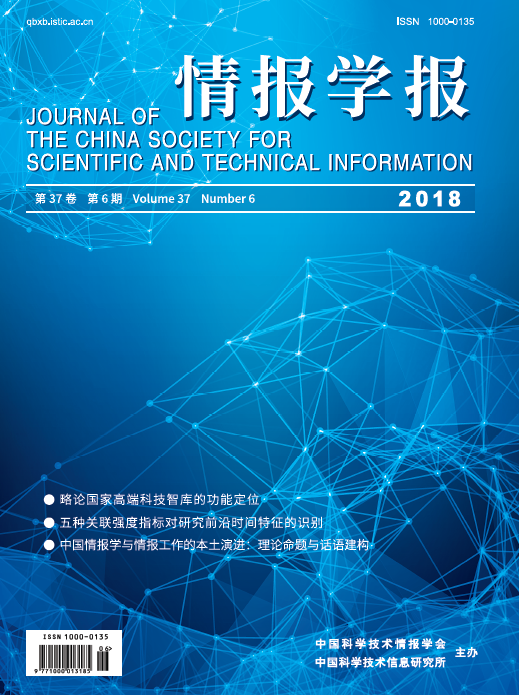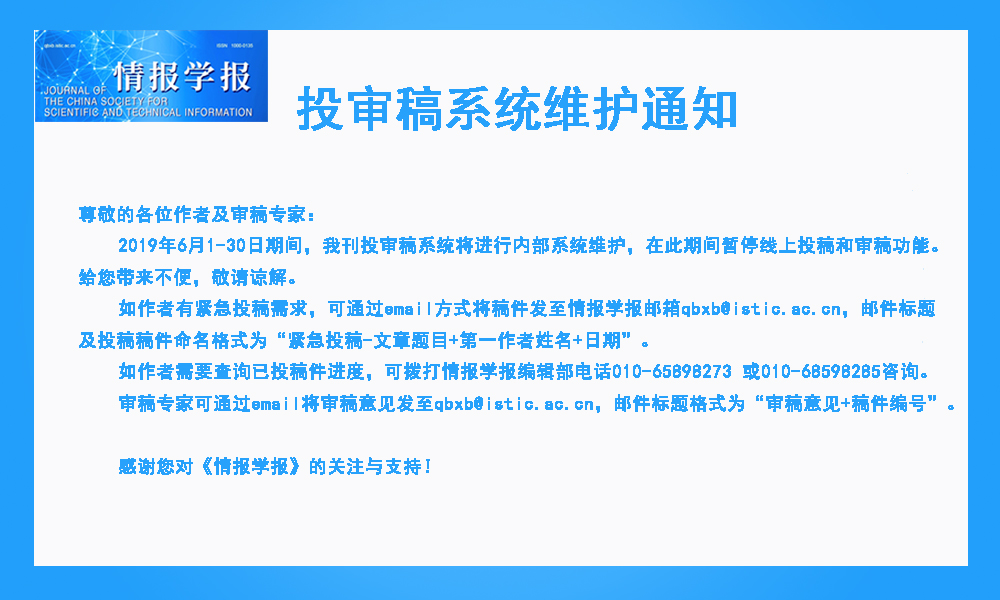 |
|
|
|
|
|
|
580 |
Constructing a Global Backbone of Science Based on Inter-category Co-membership of Journals |
|
 |
Liu Yuxian |
|
|
DOI: 10.3772/j.issn.1000-0135.2018.06.003 |
|
|
A journal can be assigned to different WoS (Web of Science) categories; hence, these WoS categories may have some journals in common. The topics contained in these common journals are different but related. Hence, the journal’s co-assignment to different WoS categories makes these categories related. We call this relationship “inter-category co-membership of journals.” The more journals the categories have in common, the more channels through which the categories can communicate and exchange, the more easily the relationship of the categories is established, and the sounder the base on which these categories form a subject clot. Based on this relationship, we use the WoS category as the basic unit to construct a backbone of science. VOSviewer’s mapping and clustering technique was used to determine the positions and clusters of WoS categories. The global map of sciences drawn by Leydesdorff and Rafols also uses the WoS category as a basic unit, but the inter-category citations were used to determine the relations. Principal-component analysis was used to cluster the categories, and the Kamada and Kawai algorithm was used for visualization. The maps, apparently, are different: the sciences are concentrated on one side and social sciences on the other in the global backbone of science drawn by the inter-category co-membership of journals. Based on inter-category citations, sciences and social sciences on the global map are trying to converge from two opposite sides, forming an irregularly circular shape. Considering the essential structure, we can see that both maps start from mathematics and computer science, which are then joined by engineering, physics, and chemistry; material science, agricultural science, and forestry; through geoscience and ecological sciences to bio-medicine; and through the public, environmental, and occupational health to the social sciences. Inter-category co-membership of journals is relatively stable, while the inter-category’s citation is mobile. The consensus and the difference may reflect the unity of the opposites of the stability and mobility of the scientific structure. They also reflect the logical structure of the two-relation frame. |
|
|
2018 Vol. 37 (6): 580-589
[Abstract]
(
297
)
HTML
(1 KB)
PDF
(1202 KB)
(
862
) |
|
|
|
590 |
A Brief Discussion of the Ten Functions of a High-end National Science and Technology Think Tank |
|
 |
Wang Shiwei |
|
|
DOI: 10.3772/j.issn.1000-0135.2018.06.004 |
|
|
With respecting to the requirements for establishing a high-end national science and technology think tank, this paper discusses the proposal of establishing a high-end national science and technology think tank; respectively explores the ten major functions of a high-end national science and technology think tank, including that of an idea center, a compass, a space for researchers, a space for popular science specialists, and a space for the development of clairvoyance, microscopes, early warning mechanisms, searchlights, sensors, and mining machines; and briefly analyzes the significance and information science values of these ten major functions. |
|
|
2018 Vol. 37 (6): 590-599
[Abstract]
(
224
)
HTML
(1 KB)
PDF
(450 KB)
(
1057
) |
|
|
|
600 |
Author Name Disambiguation Using BP Neural Networks under Missing Data |
|
 |
Ke Hao, Li Tian, Zhou Yue, Zhong Yuying, Yu Zhenglu, Yuan Junpeng |
|
|
DOI: 10.3772/j.issn.1000-0135.2018.06.005 |
|
|
Author name disambiguation plays an important role in individual-based information science, knowledge management, bibliometrics, and scientometrics. Machine learning algorithms such as clustering and classification are often employed for author name disambiguation. However, inadequate information and missing field data in metadata of publications can lead to algorithm failure. To address the said issue, this study focuses on the accurate determination of the effect of various fields in author name disambiguation under missing data. Furthermore, the proposed study analyzes existing information for determining the contributory role of each field in author name disambiguation. A unique combination of indicators was designed, and an algorithm for identifying author name repetition by incorporating BP (back propagation) neural networks was developed. The validity and reliability of the proposed algorithm was verified by employing the paper written by “Wang Wei”. |
|
|
2018 Vol. 37 (6): 600-609
[Abstract]
(
258
)
HTML
(1 KB)
PDF
(976 KB)
(
979
) |
|
|
|
610 |
Evaluation of Scholarly Impact from an Integrated Perspective of Three-Dimensional Citations: A Case Study of Gene Editing |
|
 |
Wang Feifei, Wang Xiaohan, Liu Yang |
|
|
DOI: 10.3772/j.issn.1000-0135.2018.06.006 |
|
|
Based on the integration of citation index, traditional h-index, and quantitative index of times cited, this study proposes a comprehensive and comparative approach for analyzing the influences of academic exchange, knowledge diffusion, and contribution among authors with the integration of citation analysis, social network analysis, principal component analysis, entropy weight method, and skyline operator from an integrated and comparative perspective of three-dimensional citations (author co-citation, author bibliographic coupling, and author cross citation). Next, using this idea, we conducted an exploratory research to obtain the most influential scholars in the field of gene editing. The results obtained are in good agreement with the actual situation. By introducing the weighted direct citation index, more important contributors of knowledge exchange and communication in this field were identified. |
|
|
2018 Vol. 37 (6): 610-620
[Abstract]
(
212
)
HTML
(1 KB)
PDF
(2187 KB)
(
1073
) |
|
|
|
621 |
Personalized Query Reformulations with Embeddings |
|
 |
Zhang Xiaojuan |
|
|
DOI: 10.3772/j.issn.1000-0135.2018.06.007 |
|
|
As a mechanism to guide users towards a better representation of their information need, a query reformulation method generates new queries based on those issued by users. To preserve the original search intent, most current query reformulation methods aim to obtain the context information of the query term based on the co-occurrence information between the query terms, and then use the contextual similarities to generate candidate query reformulations. These candidate query reformulations are scored eventually according to the semantic consistency of terms, dependency among latent semantic topics, and users’ preferences. However, we exploit the embeddings method to realize personalized query reformulation. First, we use the query term embedding technique to obtain the vector of each, and this vector represents the contextual information for each term. Second, the vector that characterizes users’ preferences is constructed by using the term vectors, and candidate query reformulations are generated according to user preference based on term vectors and user vectors. Finally, topic embeddings are proposed to extract the context information of each term’s latent topic, and the hidden Markov model (HMM) is used to integrate term vectors, user vectors, and topic vectors to re-rank the candidate query reformulations based on users’ personalization. The final experimental results show that this method outperforms the existing one. |
|
|
2018 Vol. 37 (6): 621-630
[Abstract]
(
226
)
HTML
(1 KB)
PDF
(375 KB)
(
985
) |
|
|
|
631 |
The Local Evolution of Chinese Intelligence Studies and Intelligence Work: Theoretical Proposition and Discourse Construction |
|
 |
Li Yang, Sun Jianjun |
|
|
DOI: 10.3772/j.issn.1000-0135.2018.06.008 |
|
|
Entering the new era, the development of intelligence studies and intelligence work in China ushered in a new development opportunity, and urgently needed new positioning, knowledge and responsibilities. In view of the common contract of the positional argument in the field of information and connotations of “intelligence”, this paper sums up the evolution logic of the localization paradigm of the development of Chinese intelligence studies and intelligence work, from exclusive intelligence to the lack of intelligence and the “physical ability” of intelligence, as well as the development of Chinese intelligence studies and intelligence work with a deep branding of the times. Owing to the present academic norm, and from a theoretical point of view, this paper holds that the development of intelligence studies and intelligence work in China is in the dual transition stage of the overall coordination of intelligence system and the comprehensive promotion of intelligence ability. The important aspect of the future development of intelligence studies and intelligence work is expounded, and the local implication of this proposition of a “physical fitness” isomorphism era is explained in depth. Based on the construction of discourse, this paper, taking the “three steps” strategy as the clue, and taking the isomorphic logic of physical energy as the core, discusses the strategic orientation and development path of Chinese intelligence studies and intelligence work in the “physical energy” isomorphism to build a new era with distinctive Chinese special intelligence studies discipline construction and intelligence cause. The direction of development is indicated. |
|
|
2018 Vol. 37 (6): 631-641
[Abstract]
(
421
)
HTML
(1 KB)
PDF
(625 KB)
(
1234
) |
|
|
|
642 |
Review of the Research on Relationship between Science and Technology |
|
 |
Dong Kun, Xu Haiyun, Luo Rui, Wang Chao, Fang Shu |
|
|
DOI: 10.3772/j.issn.1000-0135.2018.06.009 |
|
|
Science and technology are the important forces that determine the trend of scientific and technological innovation. The in-depth analysis of knowledge association and interaction mechanism between science and technology is an important prerequisite to accurately grasp the law of development trends in science and technology as well as promote policies for the transformation of innovative results. This study focuses on the research of science-technology correlation analysis and analyzes the current status of research from three aspects: the conceptual connotation of science and technology, science-technology correlation analysis method, and science-technology interaction mode. It also indicates the inadequacy of the existing research and the future research prospects. The research indicates that the concepts of science and technology are different but related to each other and have complex knowledge relations and interactions. Nevertheless, quantitative analysis is the mainstream method to analyze the relationship between science and technology mostly through the correlation analysis of papers and patents. In the future, we will enhance the accuracy of classification of the research data, reveal the semantic association of science and technology from the text-content level, introduce more standards to further divide the scientific-technical interaction modes, as well as improve the practical value of the research. |
|
|
2018 Vol. 37 (6): 642-652
[Abstract]
(
527
)
HTML
(1 KB)
PDF
(729 KB)
(
2291
) |
|
|
|


